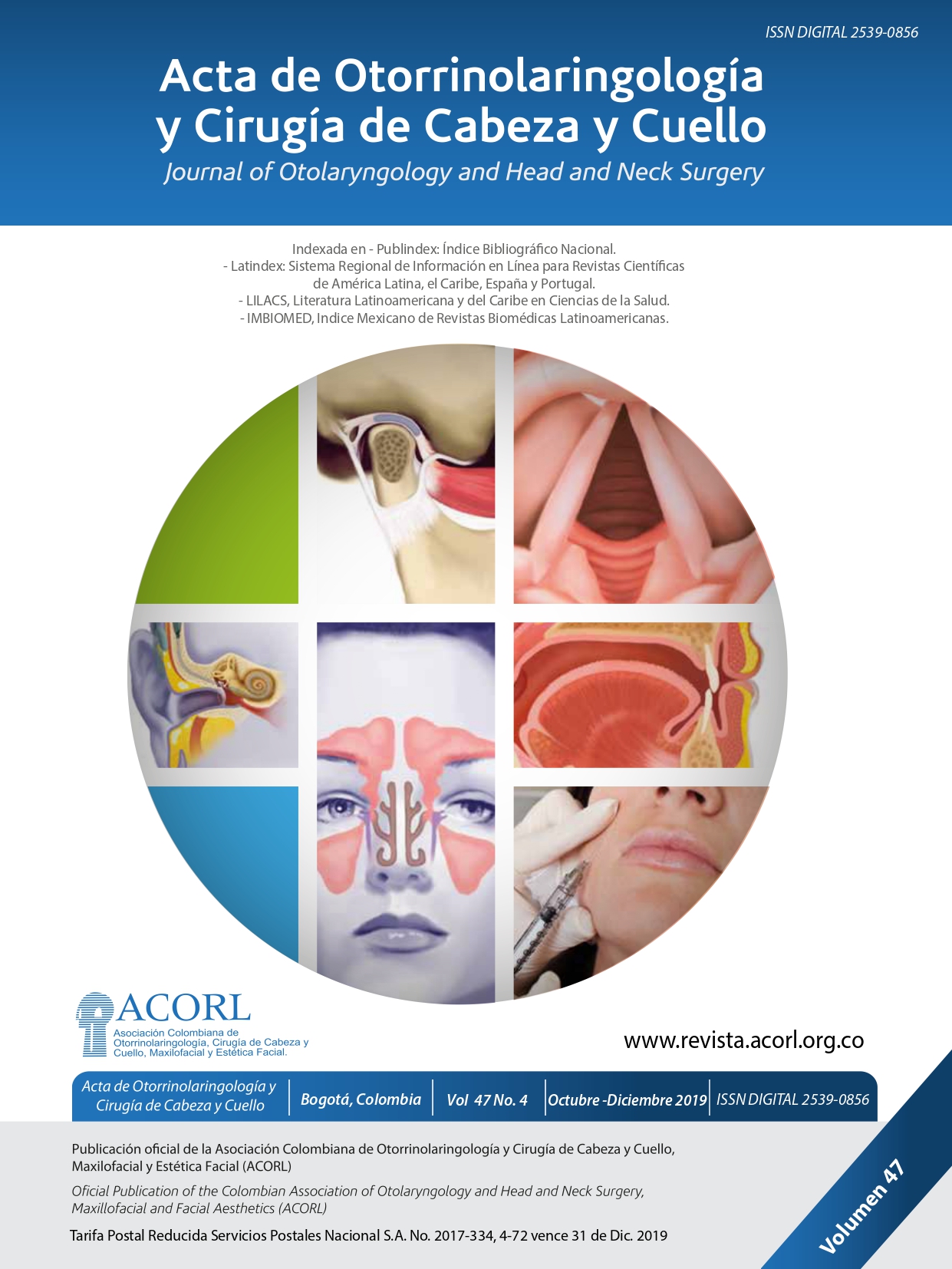Fracturas mandibulares en el servicio de otorrinolaringología y cirugía maxilofacial: experiencia en las características clínicas, diagnósticas y de tratamiento en el Hospital San José.
Contenido principal del artículo
Resumen
Introducción: el trauma facial es una de las urgencias más frecuentes del servicio
de otorrinolaringología y cirugía maxilofacial. El tratamiento debe ser dirigido
a identificar la causa y el tipo de fractura e implica que puede ser conservador o
quirúrgico. Objetivo: describir la experiencia clínica y diagnóstica de las fracturas
mandibulares en el servicio de otorrinolaringología y cirugía maxilofacial del
Hospital San José de Bogotá entre 2014 y 2018. Diseño: estudio observacional
descriptivo. Metodología: Se reclutó una cohorte de pacientes con diagnóstico de
fractura mandibular en el Hospital de San José entre 2014 a 2018. Se describieron
las principales características clínicas y demográficas, hallazgos imagenológicos,
tipo de fractura, tratamiento, complicaciones y recidivas. Resultados: se incluyeron
25 casos de pacientes con fractura mandibular durante el período descrito. El 72 % de los pacientes fueron del sexo masculino, con edad promedio de 32 (DS
11,23) años. Con etiología por: caídas, la más frecuente (40 %), accidente de tránsito
(32 %) y riña callejera (16 %). Las regiones anatómicas comprometidas con
mayor frecuencia fueron el cóndilo (20 %), ángulo (12 %) y el área parasinfisiaria
(12 %). El manejo quirúrgico estuvo presente en el 56 % de los pacientes, en los
que se utilizó el abordaje oral en el 100 % de los casos.
Conclusión: las fracturas mandibulares son frecuentes en hombres y comprometen
con mayor frecuencia al cóndilo de la mandíbula. Según el tipo de fractura y el
grado de compromiso, el manejo puede ser conservador o quirúrgico. Con baja
frecuencia en complicaciones y recidiva.
Detalles del artículo
Sección

Esta obra está bajo una licencia internacional Creative Commons Atribución-CompartirIgual 4.0.
Este artículo es publicado por la Revista Acta de Otorrinolaringología & Cirugía de Cabeza y Cuello.
Este es un artículo de acceso abierto, distribuido bajo los términos de la LicenciaCreativeCommons Atribución-CompartirIgual 4.0 Internacional.( http://creativecommons.org/licenses/by-sa/4.0/), que permite el uso no comercial, distribución y reproducción en cualquier medio, siempre que la obra original sea debidamente citada.
eISSN: 2539-0856
ISSN: 0120-8411
Cómo citar
Referencias
Fonseca RJ. Trauma oral y maxilofacial. En: Company WS (editor). Trauma oral y maxilofacial. 24.a edición. 2012. p. 912.
Cantini J, Prada R. Cirugía Craneofacial. 1.a edición. Bogotá, Colombia: FUCS; 2012.
Agudelo-Suarez A, Duque-Serna F, Restrepo-Molina L. Epidemiología de las fracturas maxilofaciales por accidente de tráfico en Medellín (Colombia). Gaceta. 2018;2(9):30-5.
Wusiman P, Abasi K, Maimaitishawuti D, et al. Management of Mandibular Angle Fractures Using One Miniplate or Two Miniplate Fixation System: A Systematic Review and Meta-Analysis. J Oral Maxillofac Surg. 2019;77(8):1673.e1-.e11.
Zapata S, Pacheco C, Núñez C, Gazitúa G, Cerda P. Epidemiología de las fracturas mandibulares tratadas
quirúrgicamente en el Instituto Traumatológico de Santiago(Chile): 10 años de revisión. Rev Esp Cirug Oral y Maxilofac [Internet]. 2015 Sep [citado 2019 Nov 2] ; 37( 3 ): 138-143. Disponible en: http://scielo.isciii.es/scielo.php?script=sci_arttext&pid=S1130-05582015000300003&lng=es. http://
dx.doi.org/10.1016/j.maxilo.2013.09.001.
Chukwulebe S, Hogrefe C. The Diagnosis and Management of Facial Bone Fractures. Emerg Med Clin North Am.2019;37(1):137-51.
Ruslin M, Brucoli M, Boffano P, et al. Motor vehicle accidents-related maxillofacial injuries: a multicentre and
prospective study. Oral Surg Oral Med Oral Pathol Oral Radiol. 2019;128(3):199-204.
Thaller SR. Management of mandibular fractures. Arch Otolaryngol Head Neck Surg. 1994;120(1):44-8.
Martins MM, Homsi N, Pereira CC, et al. Epidemiologic evaluation of mandibular fractures in the Rio de Janeiro highcomplexity hospital. J Craniofacial Surg. 2011;22(6):2026-30.
Morris C, Bebeau NP, Brockhoff H, et al. Mandibular fractures: an analysis of the epidemiology and patterns of injury in 4,143 fractures. J Oral Maxillofac Surg. 2015;73(5):951.e1-.e12.
Bormann KH, Wild S, Gellrich NC, et al. Five-year retrospective study of mandibular fractures in Freiburg, Germany: incidence, etiology, treatment, and complications. J Oral Maxillofac Surg.
;67(6):1251-5.
Gutta R, Tracy K, Johnson C, et al. Outcomes of mandible fracture treatment at an academic tertiary hospital: a 5-year analysis. J Oral Maxillofac Surg. 2014;72(3):550-8.
Naveen Shankar A, Naveen Shankar V, Hegde N, et al. The pattern of the maxillofacial fractures - A multicentre retrospective study. J Craniomaxillofac Surg. 2012;40(8):675-9.
Cabalag MS, Wasiak J, Andrew NE, et al. Epidemiology and management of maxillofacial fractures in an Australian trauma centre. J Plast Reconstr Aesthet Surg. 2014;67(2):183-9.
van Hout WM, Van Cann EM, Abbink JH, et al. An epidemiological study of maxillofacial fractures requiring
surgical treatment at a tertiary trauma centre between 2005 and 2010. Br J Oral Maxillofac Surg. 2013;51(5):416-20.
Kushner GM, Tiwana PS. Fractures of the growing mandible. Atlas Oral Maxillofac Surg Clin North Am. 2009;17(1):81-91.
Emam HA, Jatana CA, Ness GM. Matching Surgical Approach to Condylar Fracture Type. Atlas Oral Maxillofac Surg Clin North Am. 2017;25(1):55-61.
Sane J, Ylipaavalniemi P. Maxillofacial and dental soccer injuries in Finland. Br J Oral Maxillofac Surg. 1987;25(5):383-90.
Vaillant JM, Benoist M. Bullet wounds of the mandible in civil practice. Int J Oral Surg. 1981;10(Suppl 1):255-9.
Greenstein G, Cavallaro J, Romanos G, et al. Clinical recommendations for avoiding and managing surgical
complications associated with implant dentistry: a review. J Periodontol. 2008;79(8):1317-29.
Haug RH, Prather J, Indresano AT. An epidemiologic survey of facial fractures and concomitant injuries. J Oral Maxillofac Surg. 1990;48(9):926-32.
Dorafshar A, Rodriguez E, Manson P. Facial Trauma Surgery from Primary Repair to reconstruction. Elsevier; 2020.
Pickrell BB, Serebrakian AT, Maricevich RS. Mandible Fractures. Semin Plast Surg. 2017;31(2):100-7.
Wilson IF, Lokeh A, Benjamin CI, et al. Prospective comparison of panoramic tomography (zonography) and helical computed tomography in the diagnosis and operative management of mandibular fractures. Plast Reconstr Surg. 2001;107(6):1369-75.
Al-Moraissi EA, Ellis E. Surgical treatment of adult mandibular condylar fractures provides better outcomes than closed treatment: a systematic review and meta-analysis. J Oral
Maxillofac Surg. 2015;73(3):482-93.





